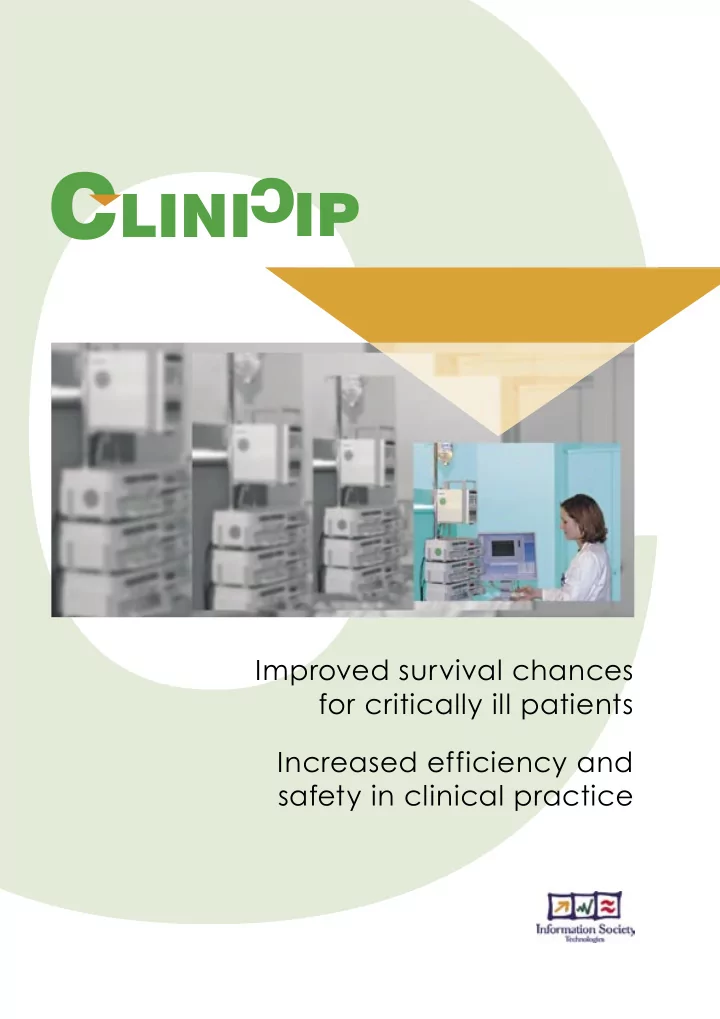

C C C C IP LINI Improved survival chances for critically ill patients Increased efficiency and safety in clinical practice
C Closed Loop Insulin Infusion for Critically ll Patients Mission Approach improve survival chances close co-operation of in intensive care medicine and engineering Clinical research Healthy people can develop atypical physiological symptoms in intensive care units. Shock and trauma of surgery may increase glucose levels and lead to Clinical research will follow a two-pronged approach, symptoms comparable to those of diabetes mellitus. including basic physiological research and practical Recent medical studies have brought evidence that clinical studies. Physiological research will focus treatment of high glucose levels with insulin will on investigating the properties and behaviour of dramatically improve survival chances in these adipose tissue under traumatic conditions and its patients. However, treatment of glycaemia with target suitability as a possible route for automated glucose glucose levels close to the physiological range is regulation. In addition, a wide range of clinical trials labour-intensive and although the cause/effect is will be carried out to test components, subsystems, well-known, hospitals are hesitant to implement and finally the complete system as developed within tight glycaemic control. the project in a clinical setting. In a combined effort, clinicians and scientists have joined forces in the CLINICIP project to develop an intelligent glucose monitoring and control system for critically ill patients . The overall goal of the CLINICIP system is to establish glycaemic control on an automated basis in order to improve survival chances in intensive care units and increase efficiency in clinical practice. A total of 13 firms, universities and non-university research organisations from all over Europe are co-operating in this Integrated Project, which is scheduled to run from 2004 to 2007.
C C C C LINI IP System development Body interface The body interface plays a key role in measuring The main platform will be developed in a stepwise glucose and metabolite levels in critically ill patients. approach, first as a decision support system still Different routes will be investigated: extravascular requiring manual glucose measurements and as well as intravascular approaches will provide thereafter as a control system with automated glucose access for the continuous measurement of glucose measurement and insulin administration to facilitate and metabolites to facilitate tight blood glucose tight glucose control. control. Infusion system Sensor system The infusion system will act as the second body Four different sensor systems will be developed to interface of the CLINICIP system . In order to measure the glucose concentration in blood and establish tight glycaemic control, the main platform interstitial fluid delivered by the body interface. communicates with the infusion system and actively Additional metabolite sensors measuring lactate, regulates the intravenous insulin infusion. carbon dioxide, oxygen and pH will be developed Data management for the characterisation of adipose tissue. Main platform All data from clinical studies will be entered into Data as provided by the sensor system is transmitted a knowledge pool where the participating medical to the main platform, which acts as the brain of institutions can store and share their findings. Data the CLINICIP system . It interacts with the and treatment recommendations will also be made control algorithm, which calculates the insulin available to hospitals outside the consortium in infusion rate. order to raise awareness about the importance of glycaemic control for critically ill patients. These centres will be invited to use the CLINICIP system to adapt their clinical work to the newly developed evidence-based practice and to expand the established knowledge pool. CLINICIP system ICU patient sensor system data pool body interface main ICU-data platform infusion system algorithm
C C LINI IP Partners JOANNEUM RESEARCH Forschungsgesellschaft mbH www.joanneum.at/iis, www.joanneum.at/msg, www.joanneum.at/cpk DISETRONIC Medical Systems AG www.disetronic.com Medizinische Universität Graz www.meduni-graz.at Technische Universität Graz www.analytchem.tu-graz.ac.at Univerzita Karlova V Praze www.lf1.cuni.cz Royal Brompton and Harefield NHS Trust www.rbh.nthames.nhs.uk Consiglio Nazionale delle Ricerche www.ifac.cnr.it SensLab Gesellschaft zur Entwicklung und Herstellung bioelektrochemischer Sensoren mbH www.senslab.de Gesellschaft zur Förderung der Spektrochemie und angewandten Spektroskopie eV www.ansci.de GAMBRO Dialysatoren GmbH www.gambro.de Katholieke Universiteit Leuven www.kuleuven.ac.be The Chancellor, Masters and Scholars of the University of Cambridge www.cam.ac.uk B.Braun Melsungen AG www.bbraun.com Coordinator Scientific Coordinator Contact Details Karin Rehatschek Martin Ellmerer JOANNEUM RESEARCH Medical Forschungsgesellschaft mbH University Graz Institute of Information Systems & Department of Internal Medicine – Information Management Diabetes and Metabolism Steyrergasse 17 Stiftingtalstraße 24 8010 Graz 8010 Graz AUSTRIA AUSTRIA Phone: +43 316 876 1144 Phone: +43 316 385 72 8 06 Fax: +43 316 876 1191 Fax: +43 316 385 72 8 39 karin.rehatschek@joanneum.at martin.ellmerer@healthgate.at w w w . c l i n i c i p . o r g
Recommend
More recommend